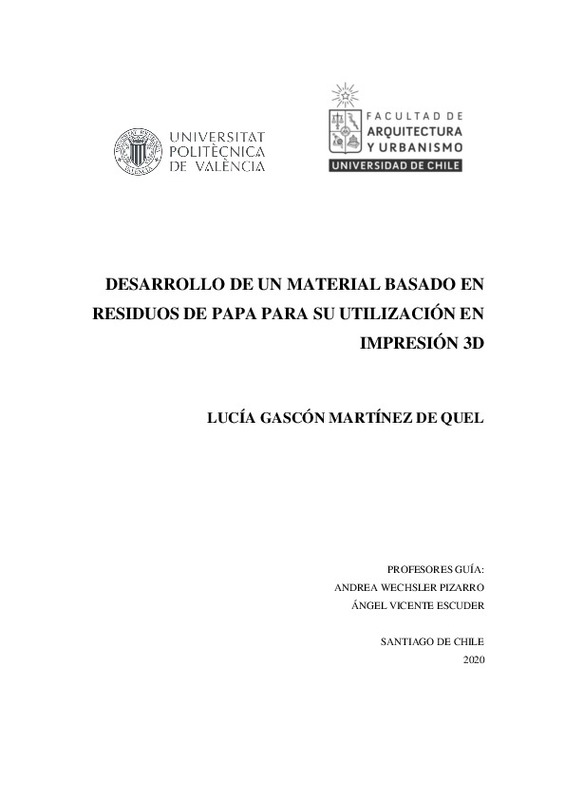|
Resumen:
|
[ES] Este proyecto tiene como principal objetivo desarrollar un material basado en los residuos de papa que genera la industria agroalimentaria chilena y adaptarlo para su implementación en la impresión 3D.
Esta ...[+]
[ES] Este proyecto tiene como principal objetivo desarrollar un material basado en los residuos de papa que genera la industria agroalimentaria chilena y adaptarlo para su implementación en la impresión 3D.
Esta investigación se desarrolló en tres etapas, en la primera etapa se identifica y caracteriza la cáscara de papa como materia prima, en la segunda se desarrolla el material basado en el almidón de la piel de la papa y en la tercera se caracteriza el material y se comprueba en la impresión 3D.
La primera etapa comienza con la investigación y determinación de la huella residual que deja esta industria en Chile y tras la revisión de las características de este residuo se define el almidón de la cáscara de papa como materia prima.
Una vez estudiado el residuo, durante la segunda etapa se define el método de extracción del almidón utilizado y, basándose en tres recetas, se llevan a cabo pruebas de fluidez con una manga pastelera con el objetivo de escoger la que mejor se adaptara a las características de fluidez esperadas.
Durante la tercera etapa se analizan las características físicas y mecánicas del material desarrollado, así como su exposición a diferentes agentes externos.
Debido al objetivo de implementar este material basado en almidón de residuos de papa en la impresión 3D se ha llevado a cabo un seguimiento de secado y se han definido diferentes parámetros vinculados a este proceso de acuerdo a sus características.
Finalmente se realizó un análisis perceptual del material desarrollado.
El material resultante demostró su capacidad de biodegradarse con un resultado de pérdida de peso, durante un mes de ensayo, de un 47,1%.
Este material desarrollado presenta buenas propiedades reológicas para su implementación en la impresión 3D y se han podido definir diferentes parámetros como el tamaño de la boca de la impresora, de 5mm de diámetro, además de la velocidad de impresión de 10 segundos para imprimir un hilo de 10 cm de largura y 4 mm de alto y ancho.
Finalmente se ha desarrollado un cuadro general con toda la información obtenida sobre el desarrollo de este material y su método de trabajo con el objetivo de orientar aplicaciones futuras.
El diseño está constantemente adaptándose a los nuevos avances para mejorar en la medida de lo posible tanto la calidad de vida como el estado de nuestro entorno. La impresión 3D está cada vez más implantada en diferentes ámbitos de esta disciplina, hecho que, en este proyecto, se relaciona directamente con la necesidad de ofrecer una alternativa de fin de vida a la gran cantidad de desechos generados, en este caso en Chile.
[-]
[EN] This project's main objective is to develop a material based on potato waste generated by the Chilean agri-food industry and adapt it for its implementation in 3D printing.
This research was developed in three ...[+]
[EN] This project's main objective is to develop a material based on potato waste generated by the Chilean agri-food industry and adapt it for its implementation in 3D printing.
This research was developed in three stages, in the first stage the potato peel is identified and characterized as raw material, in the second the material based on the starch of the potato skin is developed and in the third the material is characterized and it is checked in 3D printing.
The first stage begins with the investigation and determination of the residual footprint left by this industry in Chile, and after reviewing the characteristics of this residue, potato peel starch is defined as raw material.
Once the residue has been studied, during the second stage the method of extraction of the starch used is defined and, based on three recipes, fluidity tests are carried out with a pastry bag in order to choose the one that best suits the characteristics expected fluidity.
During the third stage, the physical and mechanical characteristics of the developed material are analyzed, as well as its exposure to different external agents.
Due to the objective of implementing this material based on potato residue starch in 3D printing, drying monitoring has been carried out and different parameters related to this process have been defined according to its characteristics.
Finally, a perceptual analysis of the developed material was carried out.
The resulting material demonstrated its ability to biodegrade with a weight loss result, during one month of testing, of 47.1%.
This developed material has good rheological properties for its implementation in 3D printing and it has been possible to define different parameters such as the size of the printer's mouth, 5mm in diameter, in addition to the printing speed of 10 seconds to print a thread of 10 cm in length and 4 mm in height and width.
Finally, a general table has been developed with all the information obtained on the development of this material and its working method with the aim of guiding future applications.
Design is constantly adapting to new advances to improve both the quality of life and the state of our environment as much as possible. 3D printing is increasingly implemented in different areas of this discipline, a fact that, in this project, is directly related to the need to offer an end-of-life alternative to the large amount of waste generated, in this case in Chile.
[-]
|







